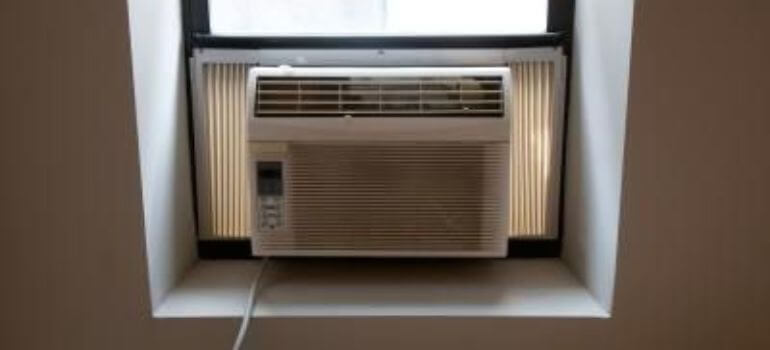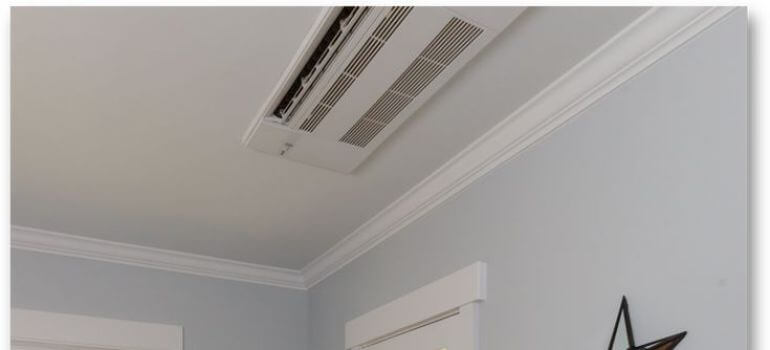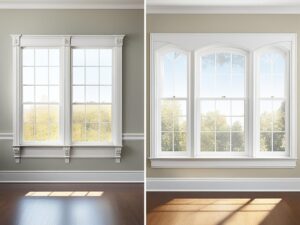When the summer heat starts to penetrate the tranquility of our homes, a reliable air conditioner becomes a true sanctuary of coolness. Yet, in the pursuit of energy-efficient cooling, homeowners find themselves weighing options between central air conditioning systems and window AC units. Understanding air conditioner efficiency is critical as we consider the best home cooling options to beat the heat without breaking the bank.
With an array of choices available, efficiency takes center stage in the decision-making process. Both central AC and window units offer distinct benefits, but their operational efficiency can impact not only your immediate comfort but also long-term utility bills. Let’s delve into the crucial differences between these two popular systems and see how they compare in the realms of energy consumption, cost-effectiveness, and suitability for your living space.
Key Takeaways
- Distinguishing the operational differences between central AC and window AC units concerning energy efficiency.
- Evaluating which cooling system aligns with specific home cooling options and personal energy-saving goals.
- Comparing cooling capacity and the consequent impact on utility bills.
- Offering insights into suitability for different home environments and usage patterns.
- Understanding the role of these systems in an overall strategy for energy-efficient cooling.
Understanding Air Conditioning Efficiency
When it comes to keeping your home comfortable during the warmer months, selecting the right air conditioning system is crucial. Not only does an efficient AC unit maintain a cool living space, but it also contributes significantly to energy savings. This section delves into the essentials of AC efficiency, helping you understand why it is a vital factor in both cost and environmental conservation.
The Basics of AC Efficiency
AC efficiency is a measure of how effectively an air conditioning unit converts electricity into cooling power. Higher efficiency means more cooling for less power, leading to reduced electricity bills and a lesser environmental impact. When shopping for cooling systems, it’s important to consider both the Seasonal Energy Efficiency Ratio (SEER) and Energy Efficiency Ratio (EER) to ensure optimal energy savings.
SEER Ratings Explained
The SEER rating gauges the cooling output during a typical cooling-season divided by the total electric energy input during the same period. The higher the SEER rating, the more efficient the air conditioner is. As of January 2023, newly manufactured AC units in the United States must have a SEER rating of at least 14 in the South and Southwest regions, and 13 elsewhere. This standard ensures that all new cooling systems contribute to significant energy savings for consumers.
EER: What Does It Mean for You?
Although the SEER rating is commonly referenced, it’s essential not to overlook the Energy Efficiency Ratio (EER). This measurement reflects the ratio of an air conditioner’s cooling capacity (in BTU/hour) to power input (in watts) at a set temperature, typically 95°F. A higher EER means the system is more efficient at that temperature, which can be particularly valuable in consistently hot climates. Understanding these efficiency metrics guides homeowners toward the most suitable cooling systems based on their unique needs and local weather patterns.
Introduction to Central Air Conditioning Systems

When it comes to maintaining a comfortable atmosphere within energy-efficient homes, central air conditioning systems are fundamental to a comprehensive HVAC solution. Unlike stand-alone cooling units, these systems provide an all-encompassing approach to regulating indoor temperatures through an intricate network of components that work seamlessly together.
At the heart of every central air conditioning system are the essential components: the compressor, evaporator, and condenser. These elements collaborate to cycle refrigerant and dissipate heat, maintaining a cool and dehumidified environment. Integrated into this process is the sprawling maze of ducted AC systems, responsible for the even distribution of air across the various rooms of a residence.
Central AC systems are typically assessed for efficiency based on their Seasonal Energy Efficiency Ratio (SEER). Higher SEER ratings often correlate with reduced energy consumption, leading to less strain on both the environment and household finances. While these systems represent a significant investment in the infrastructure of a home, they bring forth considerable benefits that align with the goal of cultivating energy-efficient homes.
- Uniform cooling: Central systems deliver a consistent temperature throughout the home, eliminating hot or cold spots.
- Lower noise levels: Unlike window units, the main noise-generating components are located outside, leading to quieter operation.
- Improved air quality: With advanced filtration systems, central AC can enhance indoor air quality by reducing dust, allergens, and other particulates.
However, the choice to install and use a central air conditioning system does come with its set of considerations. Initial setup, for instance, may require substantial modification to a home, particularly if ductwork is not already in place. Moreover, these systems demand regular maintenance to ensure efficient operation and longevity.
In summary, while the decision to go with a central air conditioning system involves upfront costs and commitment to maintenance, the payoff is a reliable, energy-efficient, and integrated system that can contribute to both the comfort and value of a home.
Window Air Conditioners: Compact and Convenient
When it comes to cooling your space, window AC units offer a flexible and user-friendly alternative to traditional systems. They are celebrated for their compact design and user-friendliness, making window air conditioners a go-to for immediate space cooling needs. Whether you’re in a residential home or looking to enhance the climate control of a rental, there are ample reasons to consider these portable air conditioners.
Pros and Cons of Window AC Units
Window AC units are lauded for their single-room efficiency and ease of installation. Portable air conditioners don’t require the complex ductwork associated with central air systems; hence, they are significantly less disruptive to set up. Despite their suitability for space cooling, they do come with drawbacks, such as limited cooling capacity restricted to the vicinity they’re installed in and possible obstruction of natural light when mounted in a window.
Installation and Mobility: Window AC Advantages
One of the foremost advantages of window air conditioners is their mobility. Unlike central units, window AC units can be uninstalled and moved to different rooms or windows as needed, which is a bonus for renters or those who frequently change living spaces. The installation process is straightforward, often requiring only a suitable window and a nearby electrical outlet.
Energy Consumption Patterns in Window ACs
Energy consumption for window AC units is generally lower compared to central systems, especially when used for cooling single rooms rather than whole houses. With energy efficiency being a priority for many households, understanding the consumption patterns is pivotal. You’ll usually find that these portable air conditioners consume less power and can lead to lower electricity bills when used strategically.
| Feature | Benefit | Consideration |
|---|---|---|
| Compact Size | Convenient for small spaces and easy to store | Not suitable for large area cooling |
| Installation | Do-it-yourself setup; no need for professional assistance | Requires a compatible window and may obstruct views |
| Mobility | Can be moved from room to room as needed | May require frequent installation and uninstallation |
| Energy Consumption | Less energy-intensive, ideal for single-room efficiency | Multiple units needed for cooling larger homes |
Central AC vs Window AC
When it comes to home air conditioning, the choice between central AC and window AC units is not just about immediate comfort. It also involves considering the efficiency of AC performance, the practicality of whole-house cooling, and the economics of AC installation cost and maintenance. In this section, we’ll delve into how both types of AC systems handle these aspects and what this means for you in the long run.
Performance and Whole-House Cooling
For those requiring a consistent temperature throughout the entire home, central air conditioning systems are unparalleled. Their design is specifically for the purpose of whole-house cooling, and they excel in providing uniform AC performance that window units simply cannot match. However, in situations where cooling needs are more localized to specific areas or rooms, window AC units may prove to be a more cost-effective and adequate solution.
Initial Costs and Installation
Considering the AC installation cost, window units generally boast a lower upfront price tag and can often be installed by the homeowner. On the flip side, the initial outlay for a central AC system is considerable, as it typically necessitates professional installation, including the need for ductwork if not already in place.
| AC System Type | Upfront Cost | Required Installation | Potential Additional Costs |
|---|---|---|---|
| Window AC | $150 – $500 | DIY Possible | Support brackets, weatherproofing |
| Central AC | $3,000 – $7,000 | Professional Only | Ductwork, Thermostat, Labor |
Maintenance and Long-term Use
When we consider maintenance and the durability for both systems, central air conditioning units often require an annual professional service to ensure they operate efficiently. They are also typically more robust and have a longer life expectancy when properly maintained. Window units, with less complex machinery and easier access, allow for more straightforward, often DIY maintenance. Yet, they may need more frequent replacements when compared to their central AC counterparts.
- Window AC: Easy to clean filters; may need replacement every 5-10 years.
- Central AC: Requires regular check-ups; life expectancy of 15-20 years.
Energy Efficiency in Central AC Systems
As the quest for eco-friendly cooling methods becomes increasingly critical, understanding Central AC efficiency is key for homeowners wanting to reduce energy consumption while maintaining comfort. Advancements in HVAC technology have revolutionized how central AC systems manage climate control, translating into substantial energy savings and reduced carbon footprints. Let’s explore the transformative impact of HVAC upgrades and how they contribute to a more sustainable future.
Recent years have seen a surge in innovative technologies designed to elevate the efficiency of HVAC systems significantly. For instance, smart thermostats have become game-changers by allowing precise control over home temperatures, adapting to user habits, and reducing energy waste. Moreover, zoning systems have ushered in an era of customized cooling, allowing different areas of a home to be cooled independently—thereby ensuring that no energy is squandered cooling unoccupied spaces.
| Feature | Energy Efficiency Benefit | Homeowner Impact |
|---|---|---|
| Smart Thermostats | Personalized climate control, reduces unnecessary cooling | Lower utility bills, increased comfort, remote management capabilities |
| Zoning Systems | Strategic cooling distribution, avoids excess energy use | Targeted comfort, enhanced system longevity, conservation of resources |
| Variable Speed Blowers | Adjustable airflow for varying demands, reduced electricity use | Quiet operation, improved air quality, refined temperature balance |
| High-Efficiency Filters | Less strain on system, improved airflow efficiency | Cleaner indoor air, reduced system wear, cost-effective maintenance |
Typical energy consumption in homes with central AC systems can vary widely based on efficiency features, lifestyle habits, and environmental factors. Nonetheless, with these advanced HVAC upgrades, homeowners can achieve significant reductions in energy usage—resulting in favorable impacts on the wallet and the environment.
At the core of energy savings is the strategic balance between maintaining an eco-friendly ethos and homeowners’ desire for comfort. By investing in the latest HVAC technologies and efficiency upgrades, we pave the way for a greener, more comfortable living space without excessive energy costs. This aligns with the broader goals of sustainability and responsible energy use, right in the comfort of our own homes.
The Impact of Room Size on AC Efficiency
Understanding the relationship between the size of a room and the efficiency of an air conditioner is critical for homeowners and businesses alike. It’s a foundational aspect of AC sizing that directly influences comfort, energy consumption, and cost. Opting for the right AC unit involves knowing how room size impact and BTU calculation come into play to ensure an energy-efficient AC sizing strategy.
Sizing Your Air Conditioner Correctly
To maintain efficiency and performance, selecting the appropriate size of your air conditioner is paramount. An oversized AC can cause short cycling, leading to excessive wear and higher humidity levels inside. Conversely, an undersized unit will run continuously, struggling to cool the space and significantly increasing your energy bills.
How Room Dimensions Affect Energy Use
The dimensions of your space are the bedrock of AC sizing. Larger areas require air conditioners with higher cooling capacities, while smaller rooms can function efficiently with units that have fewer BTUs (British Thermal Units). By considering the unique dimensions of each room, including ceiling height and windows, one can determine the most effective and efficient AC unit to employ.
Calculating BTUs for Optimal Efficiency
The number of BTUs needed for a room is calculated based on the area’s square footage. To find the square footage, simply multiply the room’s length by its width. The result corresponds with your essential BTU requirement. However, additional factors like sun exposure, room occupancy, and location must be considered for a precise calculation. To assist in this process, here’s a simplified reference table:
| Room Size (sq ft) | Required BTUs (Approx.) |
|---|---|
| 150 to 250 sq ft | 6,000 BTUs |
| 250 to 400 sq ft | 10,000 BTUs |
| 400 to 550 sq ft | 12,000 BTUs |
| 550 to 700 sq ft | 14,000 BTUs |
| 700 to 1,000 sq ft | 18,000 BTUs |
| 1,000 to 1,200 sq ft | 21,000 BTUs |
| 1,200 to 1,400 sq ft | 23,000 BTUs |
| 1,400 to 1,500 sq ft | 24,000 BTUs |
| 1,500 to 2,000 sq ft | 30,000 BTUs |
| Over 2,000 sq ft | 34,000 BTUs and above |
These figures are a general guide; each installation should be tailored to an individual’s specific environmental circumstances. Consulting with a professional can ensure that factors such as insulation, kitchen appliances, and other heat sources are properly accounted for in the energy-efficient AC sizing decision-making process.
Cost Analysis: Upfront and Operational Expenses
When considering a new air conditioning system, homeowners are faced with evaluating the AC unit cost and the broader financial implications. Initial purchase and installation represent a significant portion of the investment, but the total cost of ownership extends further, encompassing operational cost, maintenance, and potential repair expenses. To assist in this evaluation, a cost-benefit analysis is crucial, accounting for energy-saving investments and the impact of rebates or tax incentives for high-efficiency models.
| Cost Category | Central AC System | Window AC Unit |
|---|---|---|
| Initial Purchase | $3,000 – $7,000 | $150 – $600 |
| Installation | $500 – $1,200 | $0 – $50 (DIY) |
| Average Annual Operational Cost | $300 – $500 | $50 – $150 |
| Projected Lifespan | 15 – 20 years | 5 – 10 years |
| Energy Efficiency Rebates | Up to $500 | Up to $50 |
| Long-Term Energy Savings | Varies (based on SEER rating) | Varies (based on EER rating) |
For homeowners looking to make an informed decision, taking into account these expenses against the backdrop of personal cooling needs and budgetary constraints is essential. While the upfront costs for central AC systems are significantly higher, the long-term benefits of reduced energy usage and a more comprehensive cooling experience can outweigh the initial investment. Conversely, window AC units offer an inexpensive and flexible solution for targeted space cooling, but may fall short in terms of efficiency and longevity when compared with their central AC counterparts.
Conclusion
With the profusion of details now at your fingertips, the path to air conditioning decision-making should be clearer. We’ve navigated through the nuts and bolts of central and window AC systems, unraveling the numerous facets that influence their efficiency and their suitability for different living spaces. Making an informed selection hinges on balancing personal needs with the practicalities of installation, cost, and ongoing energy consumption.
Choosing the Right AC for Your Needs
In assessing your requirements, consider the size of the area you wish to cool, your budgetary constraints, and the importance of a potentially higher or lower upfront investment. Window AC units present as efficient cooling options for single rooms or smaller spaces, offering ease of installation and lower initial costs. Conversely, for a comprehensive solution that extends to the entire house, central AC systems prevail, albeit typically with higher initial outlay and installation complexities.
The Verdict on AC Efficiency
When it comes to the crux of efficiency, advancements in technology have seen significant strides in both types of air conditioners. Central AC systems, armed with higher SEER ratings, may come out on top for consistent, eco-friendly cooling across larger residential areas. However, window AC units retain their appeal for their specific application in cooling individual rooms, presenting a commendable balance of performance and energy usage.
Environmental Considerations and Final Thoughts
In our times, the imperative of environmental stewardship cannot be overstated. As consumers, opting for eco-friendly AC units underpins our collective responsibility towards a greener Earth. Recognizing that each purchase is not just personal but has wider global implications encourages thoughtful consideration of energy-efficient models that aid in curbing our carbon footprint. With the insights gathered, may you find the perfect fit to invite comfort into your space while also honoring the environment.
FAQ
What are the main differences in efficiency between central AC and window AC units?
Central AC systems typically offer a higher level of energy efficiency for whole-house cooling compared to window units that are designed for single-room use. Central AC systems often have better SEER ratings, but window AC units can be more cost-effective for smaller spaces.
How do SEER and EER ratings affect my choice of air conditioning?
Both SEER (Seasonal Energy Efficiency Ratio) and EER (Energy Efficiency Ratio) are measures of air conditioning efficiency. Higher ratings indicate more energy-efficient units. When choosing an AC, consider these ratings to better match your cooling needs with the efficiency of the unit, potentially reducing energy costs over time.
Are central air conditioning systems more efficient than window units?
Central air conditioning systems can be more efficient in terms of energy use when cooling entire homes because they are designed for larger spaces and typically have higher SEER ratings. However, for individual rooms or smaller spaces, window AC units may suffice and save energy by not cooling unused areas.
What are the pros and cons of choosing a window AC unit over a central system?
Window AC units are generally more affordable, easier to install, and can be moved as needed. They are ideal for cooling individual rooms or small spaces. However, they can be less energy-efficient for larger areas and might be noisier than central systems. On the other hand, central systems are better for cooling entire homes evenly, are quieter, and potentially more energy-efficient, but come with higher installation and maintenance costs.
How does the size of an air conditioning unit impact energy efficiency?
The size of an AC unit should be proportional to the space it’s intended to cool. An oversized unit can cause short cycling, leading to unnecessary energy consumption and wear, whereas an undersized unit will have to work harder, using more energy to maintain a comfortable temperature. Proper sizing is key to optimizing energy efficiency.
How do the initial installation costs compare between central AC and window AC units?
The initial costs for central AC systems are typically higher due to the complexity of the installation, which may include installing or modifying ductwork. Window AC units, conversely, are less expensive upfront since they are generally more straightforward to install in an existing window or wall opening.
What should I consider when calculating the long-term operational costs of an AC system?
Consider the unit’s energy efficiency, the cost of regular maintenance, the lifespan of the system, and your local energy rates. Higher efficiency units may have a higher upfront cost but can result in lower energy bills over time. Regular maintenance also plays a role in ensuring the system operates at peak efficiency for as long as possible.
Can upgrading to a more efficient central AC system be cost-effective in the long run?
Yes, upgrading to a more efficient central AC system can be cost-effective in the long run as it can reduce monthly energy bills significantly. Additionally, there might be rebates and tax incentives available for installing energy-efficient systems which can help offset the initial higher costs.
How do room dimensions affect the energy efficiency of an AC unit?
Room dimensions directly affect the capacity needed for an AC unit to cool the space efficiently. An appropriately sized unit, as calculated by BTUs (British Thermal Units), ensures optimal efficiency by running long enough to remove humidity from the air and cool the space effectively without overexerting itself or wasting energy.
Are there environmental benefits to choosing a more energy-efficient AC unit?
Yes, choosing a more energy-efficient AC unit reduces energy consumption, which can lower greenhouse gas emissions associated with electricity production. This contributes to a smaller carbon footprint and supports a more sustainable environment.



